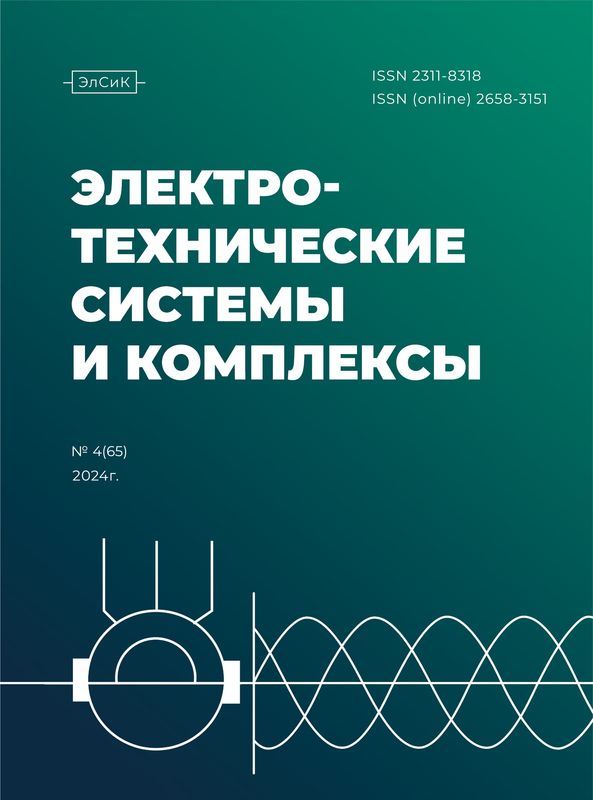Abstract
The change in the structure and digitalization of electric power production, transmission and distribution leads to the need to improve the existing methods of emergency and regime control of power systems. The introduction of renewable energy sources, combined-cycle and gas turbine plants and control systems based on power electronics lead to a decrease in the equivalent inertial constant of the power system and, as a consequence, an increase in the speed of transient processes and an increase in the uncertainty of electrical modes. As a result, the requirements for the speed and adaptability of emergency automation systems are significantly increased. In connection with the new operating conditions of modern power systems, the article proposes an adaptive system for selecting control actions to maintain static stability according to the "After" principle based on machine learning methods that have high speed and adaptability. The study proposes a method for training and applying the developed system. The numerical experiment was performed on a mathematical model of the IEEE24 power system. For the proposed system of selection of control actions for maintaining static stability, the following methods of machine learning were considered in the study: K-nearest neighbors; random forest; extreme gradient boosting; support vector machine; adaptive boosting; restricted Boltzmann machine; convolutional neural network. The choice of different machine learning methods is justified by the need to consider methods with different mathematical bases. As a result of the experiment, a random forest was chosen as an acceptable method of machine learning for the problem being solved, with an accuracy of 93% on the test sample with a delay in selecting control actions of 0.017 ms. The conclusions provide directions for further research.
Keywords
centralized emergency system, transient stability, control action, machine learning
1. Koshcheev L.A., Shulginov N.G. Emergency control system based on new generation algorithms - the next stage in the development of emergency control in power systems. Izvestiya NTTS Edinoy energeticheskoy sistemy [Bulletin of the Scientific and Technical Center of the Unified Energy System], 2013, no. 1, pp. 7-14. (In Russian)
2. Voropai N. I., Osak A.B., Smirnov S.S. Analysis of the 2016 system accident in the Unified Energy System of Russia caused by equipment damage at the Reftinskaya GRES. Elektrichestvo [Elektrichestvo], 2018, no. 3, pp. 27-32. (In Russian)
3. Carreras B.A., Newman D.E., Dobson I. North American Blackout Time Series Statistics and Implications for Blackout Risk. IEEE Transactions on Power Systems. 2016, no. 6(31), pp. 4406-4414. doi: 10.1109/TPWRS.2015.2510627
4. Xue Y., Xiao S. Generalized congestion of power systems: insights from the massive blackouts in India. Journal of Modern Power Systems and Clean Energy. 2013, no. 1, pp. 91-100.doi: 10.1007/s40565-013-0014-2
5. Senyuk M., Beryozkina S., Safaraliev M., Pazderin A., Odinaev I., Klassen V., Savosina A., Kamalov F. Bulk Power Systems Emergency Control Based on Machine Learning Algorithms and Phasor Measurement Units Data: A State-of-the-Art Review. Energies. 2024, no. 17(4), 764. doi: 10.3390/en17040764
6. Senyuk M.D., Dmitrieva A.A. Testing the Algorithm for Analysis of Dynamic Stability and Emergency Control of a Synchronous Generator on a Multi-Machine Model of a Power System. Elektrotekhnicheskie sistemy i kompleksy [Electrotechnical Systems and Complexes], 2022, no. 1 (54), pp. 46-53. (In Russian). doi: 10.18503/2311-8318-2022-1(54)-46-53
7. Alimi O.A., Ouahada K., Abu-Mahfouz A.M. A Review of Machine Learning Approaches to Power System Security and Stability. IEEE Access. 2020, vol. 8, pp. 113512-113531. doi: 10.1109/ACCESS.2020.3003568
8. Panahi H., Zamani R., Sanaye-Pasand M., Mehrjerdi H. Advances in Transmission Network Fault Location in Modern Power Systems: Review, Outlook and Future Works. IEEE Access. 2021, vol. 9, pp. 158599-158615. doi: 10.1109/ACCESS.2021.3129838
9. Yang Y., Zhang X., Yang L. Data-driven power system small-signal stability assessment and correction control model based on XGBoost. Energy Reports. 2022, no. 5(8), pp. 710-717. doi: 10.1016/j.egyr.2022.02.249
10. Gurung S., Naetiladdanon S., SangswangA. A Surrogate Based Computationally Efficient Method to Coordinate Damping Controllers for Enhancement of Probabilistic Small-Signal Stability. IEEE Access. 2021, vol. 9, pp. 32882-32896. doi: 10.1109/ACCESS.2021.3060502
11. Dorado-Rojas S.A., Bogodorova T.,Vanfretti L. Time Series-Based Small-Signal Stability Assessment using Deep Learning. North American Power Symposium (NAPS). IEEE, 2021, pp. 1-6. doi: 10.1109/NAPS52732.2021.9654643
12. Yinsheng Su, Mengxuan Guo, Haicheng Yao, Lin Guan, Jiyu Huang, SitingZhu, Zhi Zhong Power System Small-signal Stability AssessmentModel Based on Residual Graph ConvolutionalNetworks. J. Phys.: Conf. Ser. 2021, no.1(2095), 012011. doi: 10.1088/1742-6596/2095/1/012011
13. Dorado-Rojas S.A., de Castro Fernandes M., Vanfretti L. Synthetic Training Data Generation for ML-based Small-Signal Stability Assessment. IEEE International Conference on Communications, Control, and Computing Technologies for Smart Grids (SmartGridComm). IEEE, 2020, pp. 1-7. doi: 10.1109/SmartGridComm47815.2020.9302991
14. Arteaga J.-M.H., Hancharou F., Thams F., Chatzivasileiadis S. Deep Learning for Power System Security Assessment. IEEE Milan PowerTech. IEEE, 2019, pp. 1-6. doi: 10.1109/PTC.2019.8810906
15. Azman S.K., Isbeih Y.J., Moursi M.S.E., Elbassioni K. A Unified Online Deep Learning Prediction Model for Small Signal and Transient Stability. IEEE Transactions on Power Systems. 2020, no. 6(35), pp. 4585-4598. doi: 10.1109/TPWRS.2020.2999102
16. Cun X., Chen X., Geng G., Jiang Q. Online Tracking of Small-Signal Stability Rightmost Eigenvalue Based on Reference Point. // IEEE Access. 2023, vol. 11, pp. 40469-40478. doi: 10.1109/ACCESS.2023.3267802
17. Maksimenko D.M., Mashalov E.V., Neuimin V.G. State assessment based on the optimization algorithm in the RastrWin PC. Izvestiya NTTS Edinoy energeticheskoy sistemy [Bulletin of the Scientific and Technical Center of the Unified Energy System], 2013, no. 2, pp. 69.
18. Ilyushin P.V., Mokeev A.V., Narovlyansky V.G. Possibilities and Prospects of Using the USVI in Energy Regions with Distributed Energy Sources. Metodicheskie voprosy issledovaniya nadezhnosti bolshikh system energetiki [Materials of the 90th meeting of the International Scientific Seminar named after Y.N. Rudenko "Methodological issues of reliability research of large energy systems"]. Irkutsk, Federal State Budgetary Institution of Science L.A. Melentiev Institute of Energy Systems of the Siberian Branch of the Russian Academy of Sciences, 2018, pp. 28-37. (In Russian)
19. Bartolomey P.I., Shender S.E., Senyuk M.D., Klassen V.V. Centralized Protection of Long-Range Backup in a Partially Observable Electrical Network Based on Synchronized Vector Measurements. Elektrotekhnicheskie sistemy i kompleksy [Electrotechnical Systems and Complexes], 2024, no. 3 (64), pp. 12-22. (In Russian). https://doi.org/10.18503/2311-8318-2024-3(64)-12-22
20. Kaftannikov I.L., Parasich A.V. Features of the application of decision trees in problems of class. Vestnik Yuzhno-Uralskogo gosudarstvennogo universiteta. Seriya: Kompyuternye tekhnologii, upravlenie, radioelektronika. [Bulletin of South Ural State University. Series "Computer Technologies, Automatic Control, Radioelectronics], 2015, no. 3(15), pp. 26-32. (In Russian). doi: 10.14529/ctcr150304
21. Bao Y., Yang S. Two Novel SMOTE Methods for Solving Imbalanced Classification Problems. IEEE Access. 2023, vol. 11, pp. 5816-5823. doi: 10.1109/ACCESS. 2023.3236794
22. Aksyutina E. M., Belov Yu. S. Review of architectures and methods of machine learning for big data analysis. Elektronnyi zhurnal: nauka, tekhnika i obrazovaniya. [Electronic journal: science, technology and education], 2016, no. 1, pp. 134-141. (In Russian)
23. Niu R., Zeng Y., Cheng M., Wang X. Study on load-shedding model based on improved power flow tracing method in power system risk assessment. 4th International Conference on Electric Utility Deregulation and Restructuring and Power Technologies (DRPT). IEEE, 2011, pp. 45-50. doi: 10.1109/DRPT.2011.5993860
24. Isaev E.V., Kats P.Ya., Lisitsyn A.A., Nieolaev A.V., Ten E.A. Algorithm for assessing static stability and selecting control actions according to the condition for ensuring static stability in post-emergency mode. Izvestiya NTTS Edinoy energeticheskoy sistemy [News of the Scientific and Technical Center of the Unified Energy System], 2013, no. 1, pp. 48. (In Russian)
25. Glushchenko K.P. On the application of the Gini coefficient and other indicators of inequality. Voprosy statistiki [Voprosy statistiki], 2016, no. 2, pp. 71-80. (In Russian)
26. GOST 59012820.29. 240.001-2011. Automatic emergency control of power system modes. Emergency automation of power systems. Process organization conditions. Object creation conditions. Standards and requirements. Moscow, 2011.
Senyuk M.D., Pazderin A.V., Klassen V.V. Improvement of Grid Centralized Emergency System Based on Machine Learning Methods. Elektrotekhnicheskie sistemy i kompleksy [Electrotechnical Systems and Complexes], 2024, no. 4(65), pp. 14-24. (In Russian). https://doi.org/10.18503/2311-8318-2024-4(65)-14-24










